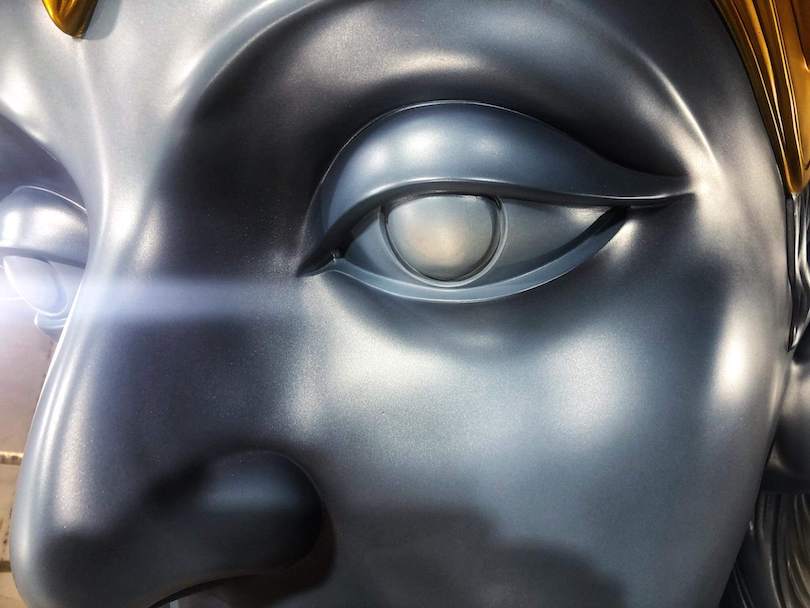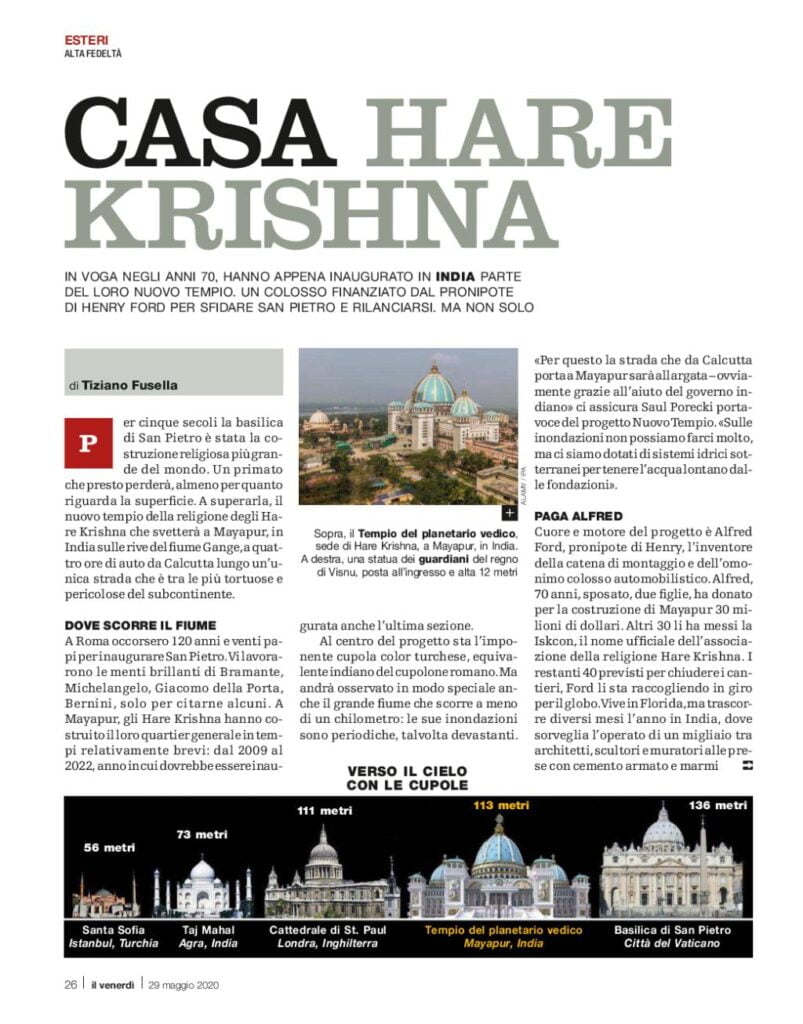Hare Krishna’s Home
By Tulasi Das | Jan 21, 2023

from the magazine of La Repubblica (Venerdì). Image Source TOVP Jay and Vijay archive
For five centuries, St. Peter’s Basilica was the largest religious building in the world. A primacy that will soon lose, at least on the surface. To overcome it, the new temple of the Hare Krishna religion which stands out in Mayapur, on the banks of the river Ganges, a three-hour drive from Calcutta, eight in times of traffic. The only road leading to Mayapur is among the most tortuous and dangerous on the subcontinent. Crossroads without signs follow one another, from which animals and vehicles of all sizes and dimensions suddenly appear.
It took Rome 120 years and twenty popes to finish the work on St. Peter’s. The brilliant minds of Donato Bramante, Michelangelo, Giacomo della Porta, Bernini worked there, just to name a few. In Mayapur, India, the Hare Krishnas built their headquarters in a relatively short time: from 2009 to 2022, the year in which the last tranche will be inaugurated.
The great river that flows less than a kilometer away remains a special observation. Its floods are periodic, sometimes devastating. «The road leading to Mayapur will be widened with the help of the Indian government – assures Saul Porecki (Sunanda das), spokesman for the new temple project -. We can’t do much about flooding, but we have underground water systems to keep the water away from the foundations”
In the center the imposing turquoise-colored dome: the Indian equivalent of the Roman dome. The heart and engine of the project is Alfred Ford (Ambarisha das), great-grandson of Henry Ford, the inventor of the assembly line and of the homonymous car giant. Alfred, 70 years old, married, two daughters, donated 30 million dollars for the construction of Mayapur. Another 30 were provided by Iskcon, the company with which the Hare Krishna religion is registered.

Picture of the orignal article
The remaining 40 planned to close the Ford yards are collecting them around the globe. Indeed, who better than him can boast good contacts with wealthy industrialists and crowned heads. He lives in Florida, but spends several months a year in India where he supervises the work of a thousand architects, sculptors and masons working with reinforced concrete and marble from Vietnam. His day begins at 4.30, as with any devoted practitioner. He always carries with him a rosary made of 108 wooden beads, recited in prayer 16 times a day. He strictly vegetarian diet, no coffee, much less cigarettes and alcohol. When, back in 1975, his parents learned from a newspaper that he had joined an unspecified sect that would surely have stolen his 1.2 billion share of the inheritance, his sister fell ill. But then she recovered. A legacy of that size did not happen. Alfred never even shaved his head, as befits the classic Hare Krishna monk. “I have one foot in religion and the other outside,” he said, but it is easy to meet him in cassock.
He was also initiated into spiritual life in 1975 by the master Bhaktivedanta Swami Prabhupada, the one who was the first to teach the monotheistic cult of the god Krishna outside India. Sister aside, Alfred found himself in the family excellent sides on the subject of oriental philosophies. His cousin William Clay Ford Jr., CEO of Ford Motor Company, is a fervent Buddhist. The progenitor Henry Ford himself frequented Sufi mystics. He revealed it in a 1926 Detroit News article that caused quite a stir. Some businessmen branded him extravagant, perhaps interested in scaling his industrial jewel if he had a disruptive mystical crisis. But there too nothing to do. Henry remained in command of the company and continued to profess reincarnation, as his heirs Alfred and Bill would do a century later.
Reincarnation will be one of the central themes of the Mayapur temple, called TOVP, an acronym of the English «Vedic planetarium temple. According to Hinduism, on which the Hare Krishnas are based, the universe is composed of multiple planetary systems, each orbiting its respective stars. Life is potentially present on every planet. Incarnated souls can wander not only from one body to another, animal or human, but also from planet to planet. A Western mind immediately thinks of Giordano Bruno, but there are no traces that the monk from Campania frequented ancient Indian writings.
A rotating representation of the universe weighing 5,000 kilos will descend from the ceiling of the left wing of the Mayapur planetarium. At the top, past the material planets, is the spiritual world where the god of Hinduism, Krishna, enjoys himself in the form of a child grappling with herds of cows, green meadows and yoghurt to steal. His fellow adventurers are none other than his own devotees of him, so immersed in rural life that they become unaware of being in the presence of God. And so they treat him like a rascal urchin like them.
The liturgy hall, called pujari, was inaugurated in February along with 69 rooms for the priests who will reside there. The TOVP temple will be able to hold 10 thousand devotees, about half of St. Peter’s Basilica, on an area of 37 thousand square meters. There will also be a 300-seat theatre, gardens, plazas, hotels, condominiums, land and a retirement community, all on 242 acres.
Elders are a central theme in the Hare Krishna religion, and a hot one. Despite being the most widespread Hindu cult beyond the Asian borders with about ten million devotees in the world, for some years there has been a rapid aging of the ranks. If since the 1960s the leader Prabhupada had managed to address an audience of young Americans and Europeans mostly from the counterculture, today the social approach has definitely changed. “Leave the materialistic society, live in the temple”, “simple life, high thinking” were the more or less implicit slogans that favored the expansion of the community in the past decades.
At Prabhupada’s death in 1977, there were more than a hundred temples. In the eighties the number of structures continued to grow, especially the farms which were still teeming with young residents cohesive in their choice of monastic life. Today the generational change is languishing. The “leave society” message no longer has the appeal it once did. Even the gathering places of Western devotees are changing. No longer large temples in the countryside but smaller, urban centers that are easy to reach.
The average age of practitioners, as there is little turnover between old and new recruits, has risen.
So some have run for cover in terms of social security. As in the USA, where 78-year-old Roger Seigel (Guru das), a devotee from the first hour, created the Vedic Care Charitable Trust, a fund to help elderly members who in their youth worked to expand the Hare Krishna movement but neglected their own sustenance in old age.
In Mayapur, on the other hand, everything is focused on the flows of tourists that the TOVP should attract, from India and the rest of the world. Six million pilgrims a year today visit the villages on the banks of the River Ganges, which have been considered sacred for centuries. It is expected that after the opening of the TOVP they will double. However, San Pietro, with its 20,139 square meters, will not lose the primacy of height: the dome of Rome exceeds Mayapur 137 against 113 meters.












